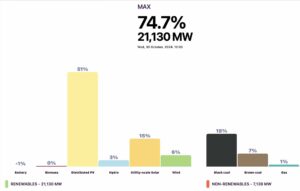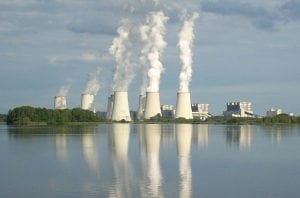Great Britain could reach net zero carbon in its electricity grid by 2050, a new report has found, but only if “immediate action” was taken across all key energy technology and policy areas – including carbon capture – and “at a significantly greater scale than assumed.”
The findings are part of latest Future Energy Scenarios (FES) report, published this week by the UK’s electricity and gas transmission system owner and operator, National Grid – one of the world’s largest investor-owned energy companies which also runs utilities in the US.
The report outlines five “Pathways to 2050”, scenarios which map out “credible pathways and scenarios for the future of energy” over the next 30 years.
Two of the scenarios meet the country’s old 2050 target of an 80 per cent reduction in greenhouse gas emissions by 2050; and a new “standalone sensitivity analysis on how net zero carbon emissions could potentially be achieved by 2050.”
The major highlight from the report is National Grid’s contention that “reaching net zero carbon emissions by 2050 is achievable,” but will require “immediate action across all key technologies and policy areas.”
Further, the 80 per cent decarbonisation target can currently be met through various technology pathways, but the net zero target will require “greater action across all solutions” including action on “electrification, energy efficiency, and carbon capture … at a significantly greater scale than assumed” in any of National Grid’s core scenarios.
To achieve net zero, British homes would need to use at least one-third less energy for heating by 2050 than today, while the electricity system would need to operate using only zero-carbon generation. Moreover, the power sector would actually need to deliver negative emissions, using technologies like biomass and carbon capture utilisation and storage (CCUS).
On top of all of that, National Grid states that the “gas system will need to be transformed to accommodate hydrogen” and “gas appliance standards must require boilers to be ‘hydrogen-ready’ in order to leverage replacement cycles.”
“We balance supply and demand of GB energy day in day out so see firsthand how the system is changing,” said Kayte O’Neill, Head of Strategy and Regulation at National Grid ESO. “Although these are not firm predictions, we’ve talked to over 600 industry experts to build this insight and it’s clear whilst net zero carbon emissions by 2050 is achievable, there are significant changes ahead.
“Electric vehicles continue to be a catalyst for decarbonizing the system, making it more flexible as well as bringing down costs for consumers too – and whilst gas will still have an important role to play, a clear plan for the decarbonization of heat is needed.
(Read more on our take of the EV component here).
“It’s our ambition to be able to operate a net zero electricity system by 2025 and the fundamental changes outlined in this report make it more important than ever to take a whole system view to ensure we have a coordinated approach to decarbonizing the whole energy sector.”
In addition to the standalone net zero by 2050 scenario, National Grid’s FES report includes four separate scenarios looking out to 2050: Two Degrees and Community Renewables both meet the UK’s 2050 80% carbon reduction target but feature different levels of decentralisation. Conversely, Steady Progression and Consumer Evolution do notmeet the 80% target.
Images: Screengrabs from the report, I think: http://fes.nationalgrid.com/media/1409/fes-2019.pdf
The report – available for free here – provides a visual representation of what level of policy support, economic growth, consumer engagement, technological development, and increase in energy efficiency will be needed for each scenario to be achieved.
Unsurprisingly, both the Two Degrees and Community Renewables scenarios require high levels of each area, with significantly high policy support and economic growth for the Two Degrees scenario, and significantly high levels of consumer engagement for the Community Renewables scenario.
In the Community Renewables scenario, emissions were forecast to drop from 503 MTeCO2 to 165 MTeCO2 by 2050, relying on a larger role for district heat and hybrid heat pumps, earlier growth in electricity storage capacity, and surprisingly, reduced solar capacity.
Increased offshore wind capacity and decreased nuclear capacity – as well as thermal efficiency – is common across all scenarios.
Conversely, the Two Degrees scenario will see emissions similarly drop to 165 MTeCO2 by 2050 with a higher demand for hydrogen for heating and commercial transport, and the introduction of hydrogen from electrolysis and small nuclear reactors will be necessary.
The two scenarios which will not meet the 80% reduction – Steady Progression and Consumer Evolution – naturally see much less activity across the five areas of growth necessary, and similarly see much less drastic reductions in emissions – dropping to 345 MTeCO2 and 344 MTeCO2 respectively.
Finally, a common factor across all scenarios is the role that electric vehicles will be able to play to help decarbonise both the transport and electricity supply sectors across Great Britain. In order to harness the benefits of electric vehicles, vehicle charging would need to complement renewable generation and meet system needs.
According to National Grid, the charging of over 35 million electric vehicles in 2050 would provide “flexibility and integrate a higher level of renewable generation on the system” which will amplify “the positive impact of electric vehicles on decarbonisation.”
Smart charging vehicles could enable the storage of approximately one-fifth of Great Britain’s solar generation for when the energy is needed, and over 75% of electric vehicles could be using smart charging by 2050.










